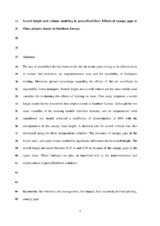Scorch height and volume modeling in prescribed fires: effects of canopy gaps in Pinus pinaster stands in Southern Europe
Autor
Molina, Juan Ramón
Ortega, Macarena
Rodríguez y Silva, Francisco
Editor
ElsevierFecha
2022Materia
Fire behaviorFire management
Fire impact
Fuel treatment
Thermal pruning
Canopy gaps
METS:
Mostrar el registro METSPREMIS:
Mostrar el registro PREMISMetadatos
Mostrar el registro completo del ítemResumen
The use of prescribed fire has been on the rise in recent years owing to its effectiveness in surface fuel reduction, its implementation cost, and the possibility of firefighter training. However, greater knowledge regarding the effects of fire on woodlands is required by forest managers. Scorch height and scorch volume are the most widely used variables for evaluating the effects of burning on trees. This study proposes a scorch height model for the prescribed fires of pine stands in Southern Europe. Although the two main variables of the existing models (fire-line intensity and air temperature) were considered, our model achieved a coefficient of determination of 89% with the incorporation of the canopy base height. A decision tree for scorch volume was also developed using the three independent variables. The presence of canopy gaps in the lower, mid-, and upper slopes resulted in significant differences in the scorch height. The scorch height increased between 0.33 m and 2.08 m because of the canopy gaps in the upper slope. These findings can play an important role in the implementation and improvement of prescribed burn windows.

